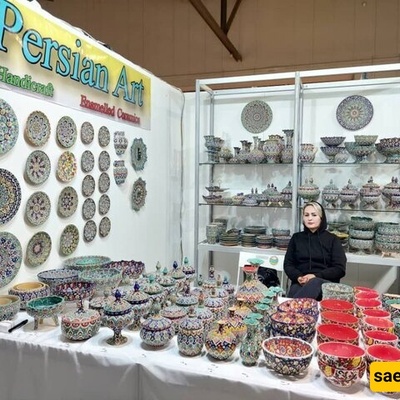Saed News: *Sekanjabin* holds a special place in traditional Iranian medicine and is used as an herbal remedy for detoxifying the body and improving digestion. Stay with us as we explore the history, benefits, preparation method, and practical tips for this popular drink.

According to the Saed News Cooking Service, on hot summer days or whenever you feel thirsty, few drinks can quench your thirst and be as pleasant as Sekanjabin. This delicious and traditional Iranian syrup is made from a simple combination of vinegar and a sweetener like honey or sugar. With the addition of mint, it becomes a fragrant and refreshing beverage. In Iranian traditional medicine, Sekanjabin holds a special place and is known as an herbal remedy for detoxifying the body and strengthening the digestive system. Stay with us to learn more about the history, benefits, preparation method, and useful tips related to this popular drink.
Sekanjabin is essentially a combination of "vinegar" and "angabin" (which means honey). The name itself reflects its essence: a syrup made from vinegar and a sweetener such as honey or sugar. This beverage is not exclusive to Iran; similar versions can be found in neighboring countries and even in parts of the Mediterranean region under different names and preparation styles.
Sekanjabin has ancient roots and is extensively discussed in traditional Iranian medicine texts, such as Avicenna’s Canon of Medicine, which outlines its properties and preparation. This indicates that Sekanjabin has long been used both as a flavorful drink and a medicinal herbal remedy. Moreover, before the invention of refrigeration, Sekanjabin was also used for its preservative qualities in addition to its therapeutic benefits.
Thanks to its ingredients, Sekanjabin offers many health benefits. Here are a few:
Thirst-Quenching and Cooling: The most notable benefit of Sekanjabin is its ability to quench thirst and cool the body, especially during the hot seasons. The combination of vinegar and sweetness helps regulate body fluids and provides a refreshing sensation.
Liver Detox and Digestive Aid: The vinegar in Sekanjabin assists in detoxifying the liver and enhancing its function. It also aids digestion and helps relieve gastrointestinal issues such as bloating and constipation.
Energy Boost and Fatigue Relief: Thanks to natural sugars (especially when honey is used) and the acetic acid in vinegar, Sekanjabin can boost energy levels and reduce fatigue.
Fever and Inflammation Reduction: In traditional medicine, Sekanjabin is recommended for lowering fever and reducing body inflammation.
Improves Blood Circulation: Some traditional sources suggest that Sekanjabin can help dilate blood vessels and improve blood circulation.
Making Sekanjabin is not difficult, and by following a few simple steps, you can easily prepare this delightful drink at home.

White or red grape vinegar: 1 liter (Preferably homemade or high-quality vinegar)
Sugar: 1 to 1.5 kilograms (Adjust based on taste and the sourness of your vinegar. For a more traditional taste, you may use natural honey instead and adjust the quantity based on its sweetness.)
Water: 1 liter
Fresh mint: A few sprigs (about 50 to 100 grams for better aroma and flavor)
A large, clean pot
A wooden or Teflon spoon for stirring
A clean cloth or fine strainer for filtering
Prepare the Mint: Clean and wash the mint carefully. Bundle it together and tie it with clean thread. (This helps prevent the leaves from spreading in the syrup and makes removal easier.)
Combine Water and Sugar: In a large pot, mix water and sugar. Place it over low heat and stir gently until the sugar is completely dissolved.
Add the Vinegar: Once the sugar has dissolved, add the vinegar to the water-sugar mixture. Increase the heat slightly and bring it to a boil.
Add the Mint: Once it starts boiling, add the bundle of mint into the pot.
Simmer and Thicken: Lower the heat and let the syrup simmer gently. Foam will appear on the surface, which should be skimmed off with a spoon. This step helps clarify the syrup. The thickening time varies depending on the heat and volume—usually between 45 minutes to 1.5 hours. The syrup should reach a consistency where it flows slowly like runny honey when lifted with a spoon.
Test the Consistency: To test, pour a drop on a cold plate and let it cool. If it holds its shape and appears jelly-like, the syrup is ready.
Remove the Mint: Once the desired consistency is reached, turn off the heat and remove the mint bundle.
Strain and Store: Let the Sekanjabin cool slightly. Then strain it through a clean cloth or fine mesh to remove any particles. Pour the filtered syrup into clean, dry glass bottles and store in a cool, dark place or in the refrigerator.
Ingredient Quality: Using high-quality vinegar and sugar or honey significantly affects the final flavor.
Sweetness Level: Adjust sugar or honey to your taste. Sour vinegar requires more sweetness.
Mint Type: Use fresh and aromatic mint. You may also add a bit of dried mint for extra fragrance.
Pot Size: Use a large enough pot to allow for boiling and to prevent overflowing.
Stir Occasionally: Stir the syrup occasionally during simmering to prevent the sugar from settling and sticking to the bottom.
Storage: Store Sekanjabin in clean bottles in the fridge. Thanks to the preservative quality of vinegar, it has a long shelf life.
Sekanjabin is usually served cold, diluted with some water. You can add some grated or sliced cucumber to enhance its flavor and benefits. One of the most popular ways to enjoy Sekanjabin in Iran is with lettuce and cucumber. This not only makes for a delicious combination but also enhances hydration—perfect for hot weather.

